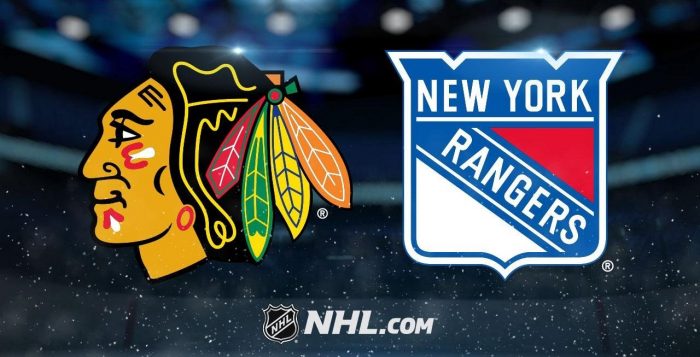This Day in Hockey History – January 5, 1957 – NHL on TV in USA
A little over four years after Hockey Night in Canada was first televised, the U.S. began nationally televising NHL games. The network CBS broadcast a series of ten Saturday afternoon games for the NHL beginning on January 5, 1957.
As of late December 1956, the Boston Globe reported that WEEI staffer Fred Cusick would serve as “color” man for Bud Palmer, who would do play-by-play for the upcoming television series. The duo kept their roles for three seasons before Cusick took over the play-by-play and Brian McFarlane was brought on for color commentary and interviews. The series would be called Game of the Week.
The first of the televised games featured the Chicago Blackhawks visiting the New York Rangers at Madison Square Garden. Rangers president Gen. John Reed Kilpatrick disapproved of censorship and said, “The camera will be on the action wherever and whatever it is.” His general manager, Muzz Patrick, concurred. “The people will want to see what goes on. The camera will be on the action.” Going into the game, the Rangers only worried about their current slump, having lost five of their last six games. To their relief, the “merry matinee” went their way before the 9,853 at the Garden and the national television audience. The Rangers scored in each of the first two periods. Although the Blackhawks managed one goal in the first minute of the third, the Rangers came back with two goals in 20 seconds of the final minute. After ten penalties and a couple fights, the Rangers defeated the “cellared Chicagoans” 4-1.
The television experiment seemed a success after that initial game. NHL President Clarence Campbell said that knowing “there’s a lot of interest in hockey in this country,” the televised games “can’t help but stimulate interest around the country.” After all, as Gene Ward wrote for the New York Daily News, hockey would be “sent into such locales as Mobile, New Orleans, Houston, Los Angeles and Hollywood, places where, until now, the only ice seen has been in a highball glass.” Despite the difficulties the cameras had in following the “speedy action,” Campbell “heard good results” and was “certain it’ll get better in the other games.” In fact, cities with NHL teams had already seen increases in attendance after the first few games aired. Campbell’s true goal in national televising was to “create new fans in the United States and eventually result in bringing some American players into our league.” Out of the 100 or so NHL players, only Gerry Foley of the Rangers was American-born instead of Canadian. However, his aim was to strengthen the Original Six teams before even considering expanding into new cities. On the other hand, Bruins owner Walter Brown noted, “TV will introduce the game and excite interest in a lot of places where ice hockey is dormant. I think it’s entirely possible TV will create a few new potential ‘areas’ for the N.H.L.” Already by the end of January, the channels carrying the games had doubled and, according to Jerry Nason of the Boston Globe, “an astonishing interest in ice hockey is evident now in Dixie.” Nason noted that although the NHL might like to expand to eight teams, the shortage of players (primarily only coming out of Canada) would hinder that expansion.
The 10-game series was scheduled through March 9. Three U.S.-based teams (the Rangers, Bruins, and Red Wings) would play in half the games, and the Blackhawks would play in four. The only Canadian team to appear would be the Montreal Canadiens for a Boston matchup. When the first season “proved so successful,” the NHL increased the number of Saturday afternoon games to be televised. For the 1957-58 season, 21 NHL games would be broadcast between November 2 and March 22. However, ratings eventually slumped, and the CBS series only lasted four seasons. The hoped-for NHL expansion took ten years to come to fruition.
Additional Sources:
- https://www.nhl.com/gamecenter/chi-vs-nyr/1957/01/05/1956020111#game=1956020111,game_state=final
- Fred Cusick, Fred Cusick: Voice of the Bruins (Champaign, Ill.: Sports Publishing LLC, 2006), 70-72, 160-161.
- Jerry Nason, “Around and About,” Boston Globe, 29 Dec. 1956, sports, p. 4.
- Chris Kieran, “TV Cameras Won’t Censor Ice Battles,” New York Daily News, 4 Jan. 1957, p. 56.
- Joe Trimble, “Rangers Romp 4-1, in TV Tilt” and “Rangers Rip Hawks 4-1, in TV Game,” New York Daily News, 6 Jan. 1957, p. C28 and 90.
- Gene Ward, “Inside Sports,” New York Daily News, 6 Jan. 1957, p. 92.
- “NHL President Expects TV To Make New Fans,” Troy Times Record, 8 Jan. 1957, p. 17.
- Jerry Nason “TV Spreads Appeal, but: Shortage of Players Hurts N.H.L.’s Chances of Adding to Fold,” Boston Globe, 25 Jan. 1957, p. 14.
- “NHL Doubles Television Schedule,” Troy Times Record, 22 May 1957, p. 25.














